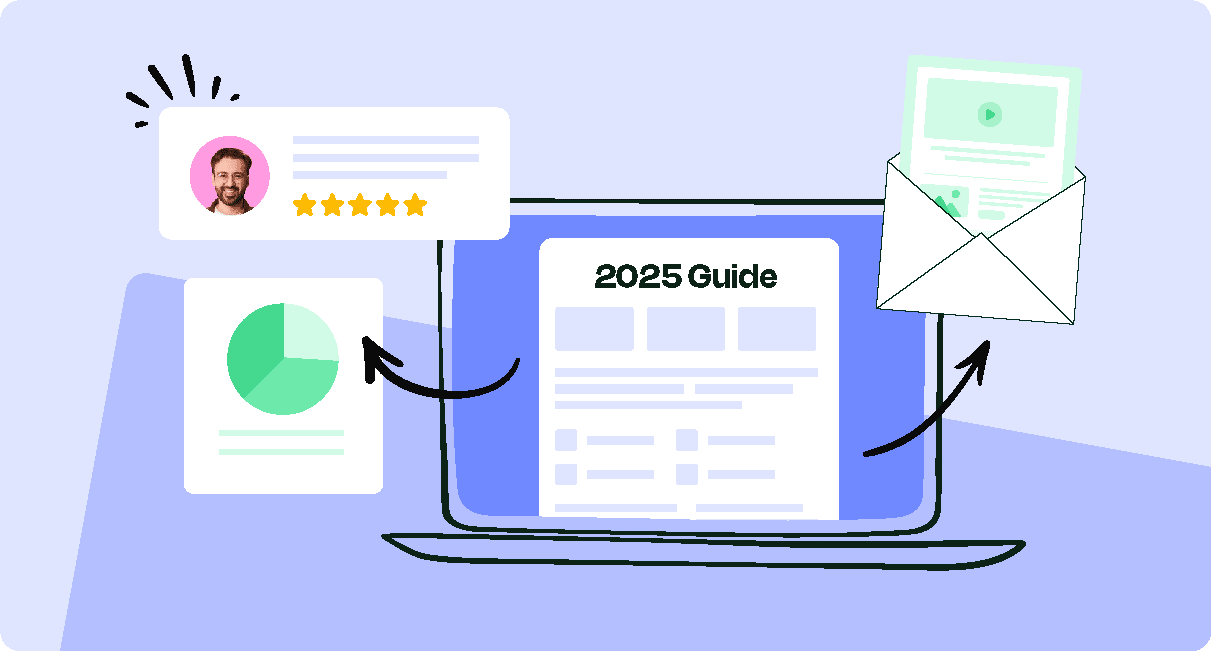Employee engagement is the difference between teams that thrive and teams that check out. But what actually drives engagement? This guide breaks down the 15 key drivers of employee engagement that matter most in 2025—and how to activate each one with clarity, purpose, and data.
You can’t fake engagement. Employees know the difference between being talked at and being truly seen. They feel it when the surveys are surface-level, when the perks are performative, when leadership says “culture” but doesn’t show up for it.
In 2025, the workplace is louder than ever—AI tools, back-to-office debates, nonstop pings. But beneath the noise, the fundamentals haven’t changed. People still want to feel something at work.
That’s where the real work of engagement begins. Below, we break down the 15 key drivers of employee engagement that matter now and how to bring each one to life in your organization.
Take a self-guided tour of ContactMonkey
See how our key features can streamline your internal communications.
Take product tour

What is Employee Engagement in 2025?
Employee engagement is the level of enthusiasm, commitment, and connection an employee feels toward their work, their team, and their company’s mission.
Employee engagement in 2025 isn’t about whether someone’s happy on the job. It’s about energy, ownership, and emotional investment.
How employee engagement drives growth is no longer a mystery. Thanks to data-driven tools, real-time analytics, and continuous feedback loops, we can now connect engagement to performance, retention, innovation, and the bottom line.
BONUS: Want to understand how to measure employee engagement, exactly? Read our guide!
What are the Drivers of Employee Engagement?
Drivers of employee engagement are the foundational factors that influence how connected, motivated, and committed employees feel toward their work and their organization. These include leadership quality, meaningful communication, recognition, growth opportunities, and a positive work environment.
Unlike surface-level perks or motivational slogans, the true drivers of employee engagement are built into the everyday employee experience. They shape how employees show up, how they contribute, and how they feel about the future.
Understanding these factors is important for organizations looking to create data-driven employee engagement strategies that lead to long-term growth and retention.
What Drives Employee Engagement?
At its core, employee engagement is emotional. It’s about whether people feel seen, valued, and empowered to do their best work.
At the highest level, these six factors drive the most impact for employee engagement:
- Strong leadership that communicates vision and models values.
- Recognition that feels personal, consistent, and meaningful.
- Clear, two-way communication across the organization.
- Opportunities for growth, learning, and advancement.
- A supportive and inclusive work environment.
- A sense of purpose that links individual roles to company goals.
Start two-way conversations and employee feedback loops
Learn how to engage staff with pulse surveys, content ratings and reactions, custom polls, and more. Ready to send modern emails?
See engagement features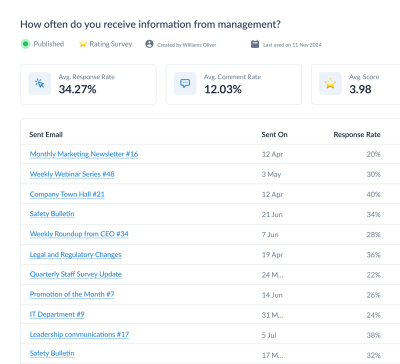
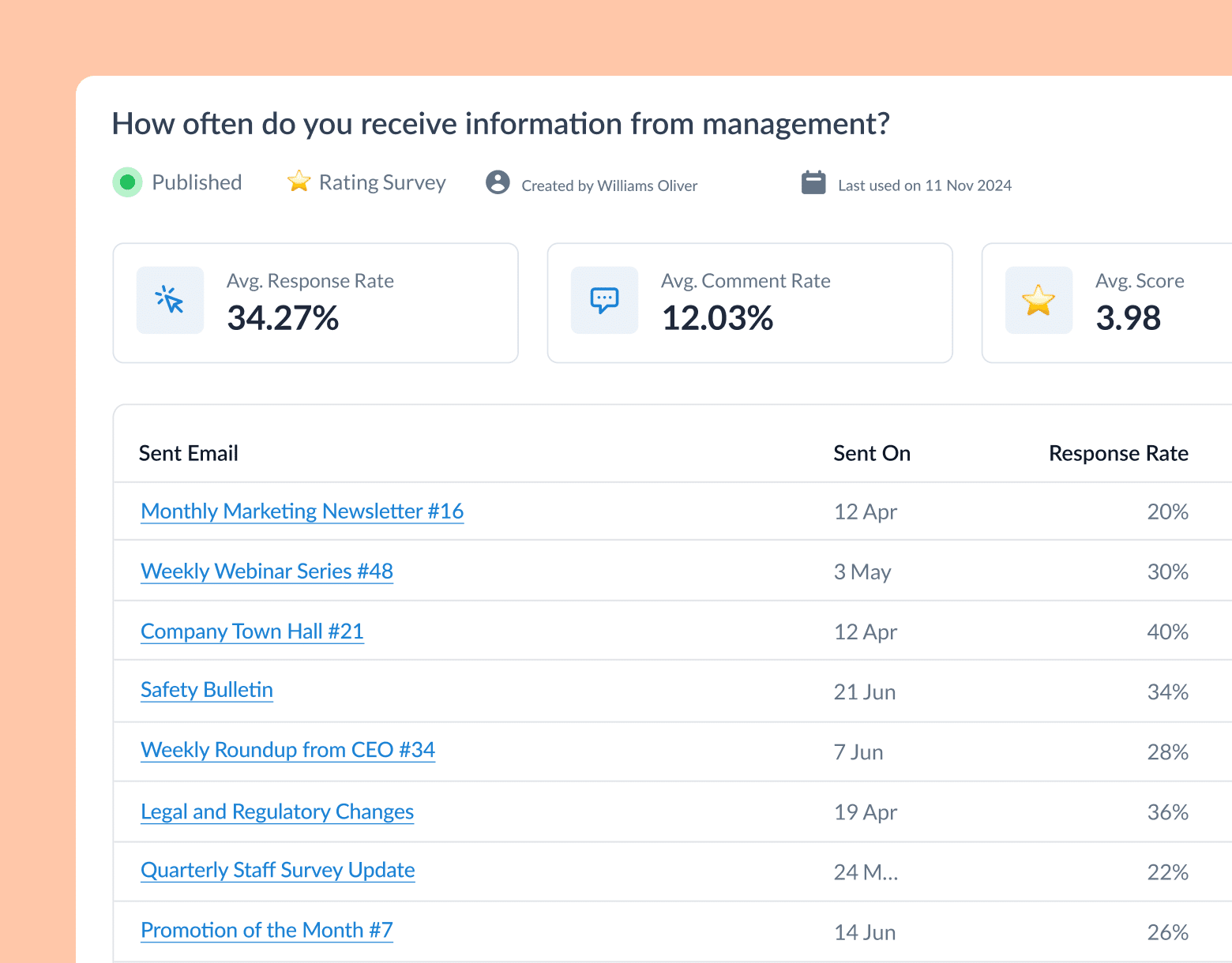
Who Drives Employee Engagement?
It’s tempting to think employee engagement is HR’s job. Or the CEO’s. Or the managers’. But really, everyone drives employee engagement.
Yes, senior leadership sets the tone. They define the vision, shape the culture, and decide what gets prioritized. Managers turn that vision into a daily reality, offering feedback, coaching, and recognition that directly impact engagement levels. But employees also play a role through the way they collaborate, support one another, and show up with curiosity and care.
In short:
- Leaders inspire employee engagement.
- Managers activate employee engagement.
- Employees shape and sustain employee engagement.
And with the right employee engagement tools, strategies, and shared accountability, it becomes a team effort. The result is a more resilient, motivated, and connected workforce powered by data-driven employee engagement that scales.
15 Most Important Drivers of Employee Engagement
Below are the everyday forces that quietly shape how employees feel about their work and what they give back in return. Each one is a lever. Together, they create a culture and a company people actually want to work for.
Here are the 15 most important drivers of employee engagement:
1. Recognition that feels personal, timely, and true
When someone goes above and beyond and nobody says a word? It kills engagement. Recognition is one of the fastest ways to show people they matter—and it’s one of the top drivers of employee engagement across industries.
Why this is important for the business: Companies that prioritize recognition see 31% lower turnover (SHRM). It’s a simple, scalable way that explains how employee engagement drives growth.
Why this is important for employees: Employees who have been recognized are 45% less likely to turn over two years later (Gallup). Recognition reinforces purpose and turns effort into pride.
Actionable examples:
- Weekly “shoutouts” in team meetings that spotlight specific actions.
- A digital “kudos wall” in your employee newsletter.
- Real-time recognition features inside your employee engagement software.
Picture this: A team member wraps up a project that’s been six weeks in the making. That afternoon, they open their inbox and see a company-wide message highlighting their role in its success. Their face lights up because they feel seen.
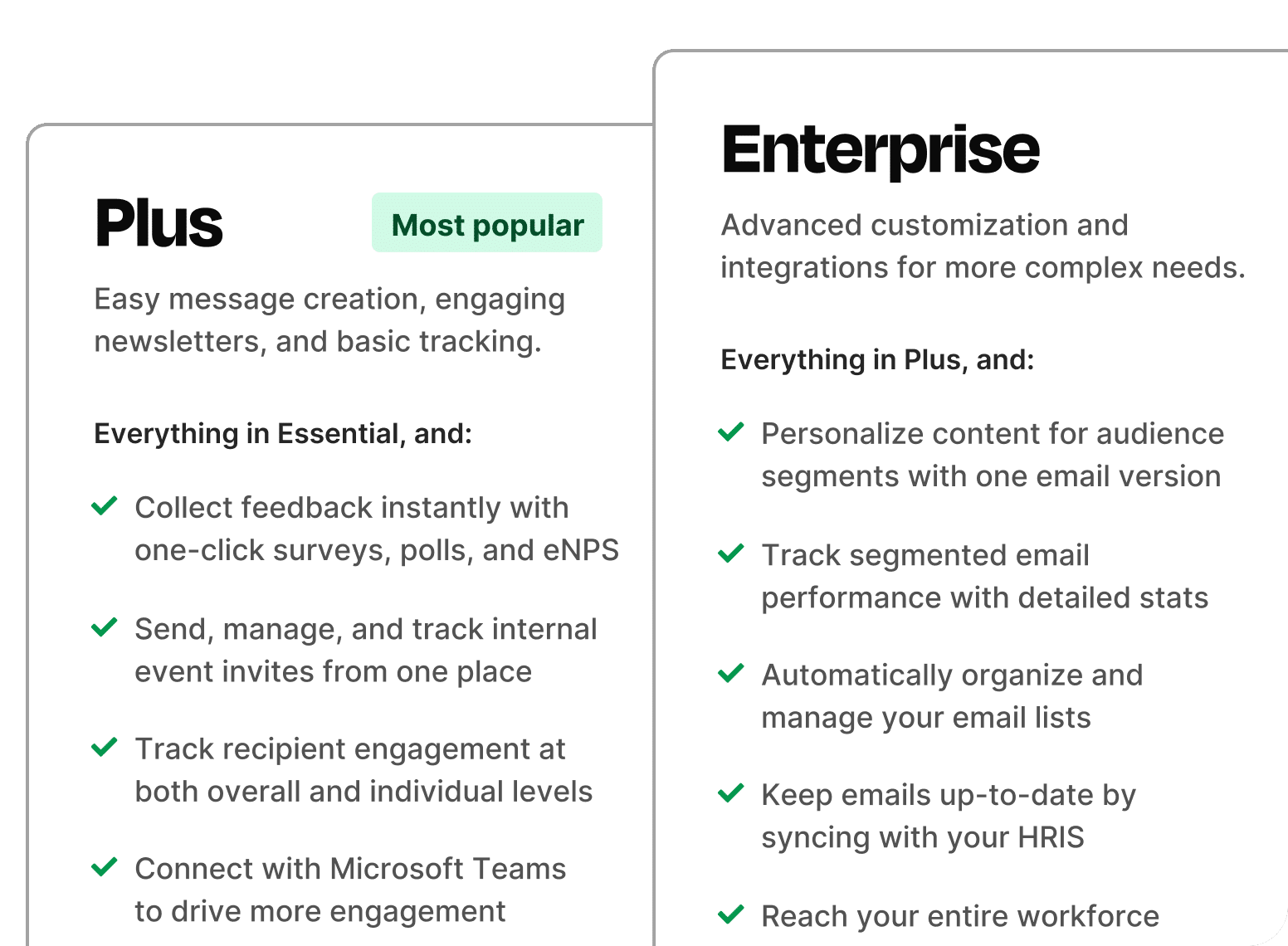
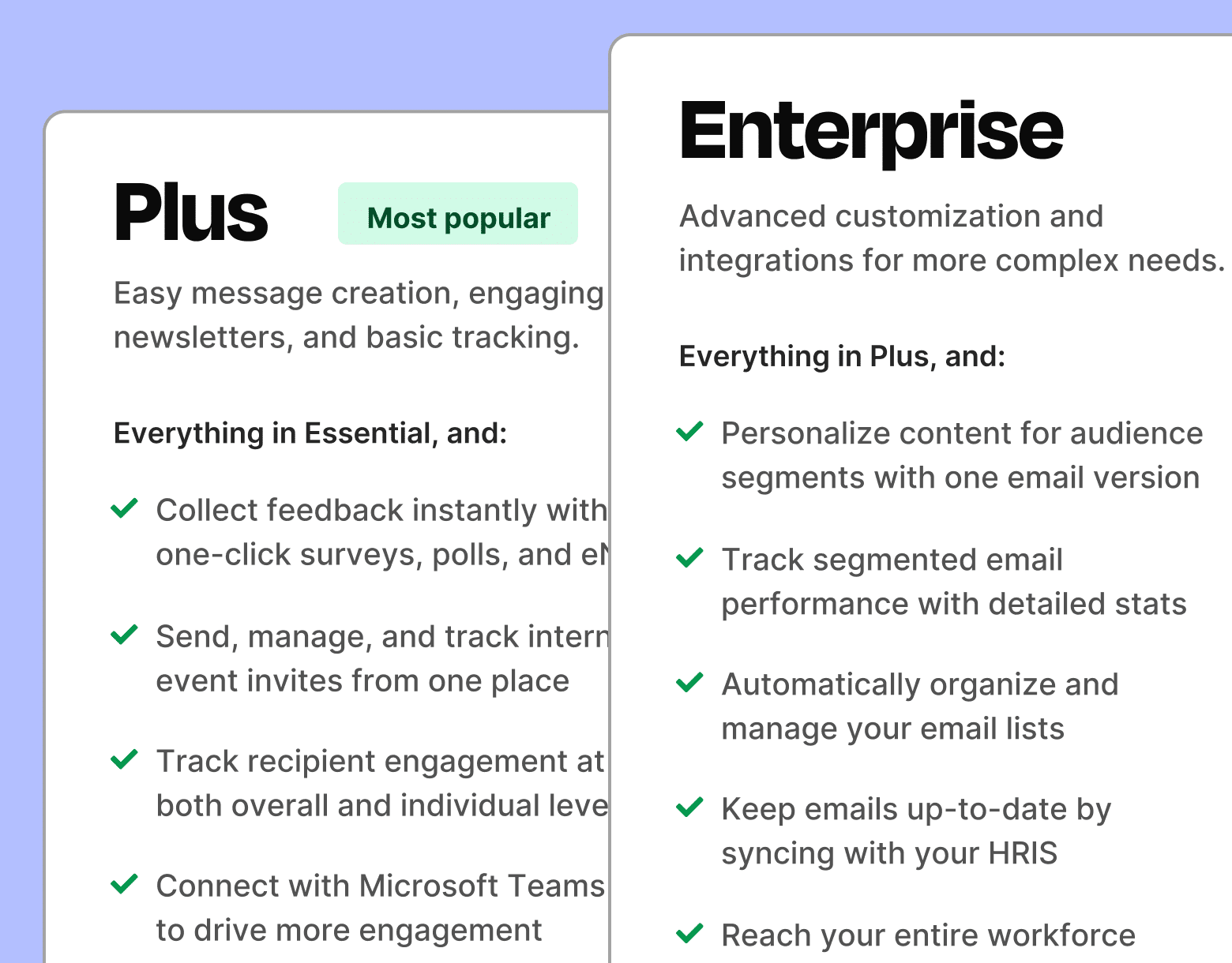
2. Leadership that communicates, models, and listens
Engagement starts at the top. Leaders set the tone for culture, values, and how people treat one another. But vision and showing up with clarity, consistency, and empathy are equally important. Strong leadership is one of the clearest factors that drive employee engagement.
Why this is important for the business: Companies with effective leadership are 3.4x more likely to be high-performing (DDI). That’s data-driven employee engagement in action.
Why this is important for employees: Gallup‘s research indicates that managers account for 70% of the variance in team engagement, underscoring the significant role leadership plays in influencing employee engagement levels. When leaders communicate transparently, trust grows and anxiety shrinks.
Actionable examples:
- Monthly “Ask Me Anything” sessions with your CEO or leadership team.
- Leadership visibility in employee newsletters, Slack, or internal videos.
- Include questions like “Do you trust leadership to communicate openly?” in your employee engagement survey.
Picture this: It’s a rough quarter. Instead of radio silence, your CEO sends a 2-minute video. She acknowledges the challenge, outlines what’s next, and thanks the team. That’s leadership people want to follow.
3. Growth opportunities that go beyond job titles
Employees don’t just want a role, they want a runway too. When people see a path to grow, learn, and advance, they’re more likely to invest their energy and ideas.
Why this is important for the business: Organizations that invest in employee development experience 11% greater profitability and are twice as likely to retain their employees, according to Gallup. This underscores how employee engagement drives growth through retention and future-ready skills
Why this is important for employees: Learning fuels purpose. It keeps people from feeling stuck and helps them believe their best work is still ahead.
Actionable examples:
- Quarterly “growth chats” between managers and direct reports.
- Internal mentorship programs that pair up cross-functional colleagues.
- Learning budgets tied to personal development, not just role-specific skills.
Picture this: A junior marketer expresses interest in data analytics. Her manager sets her up with a Tableau course and a 30-day challenge to visualize newsletter metrics. She’s lit up. She’s learning. She’s staying.
4. Communication that flows both ways
Want to know how to improve employee engagement fast? Start by listening. Top-down communication isn’t enough. Employees want clarity, yes—but also channels where they can give feedback, ask questions, and feel heard.
Why this is important for the business: Clear internal communication is foundational to any data-driven employee engagement strategy. When organizations communicate well, employees are more aligned, more confident in leadership, and better equipped to deliver results. It’s how high-performing teams stay in sync and how strategy turns into execution.
Why this is important for employees: Two-way communication builds trust. When people feel informed and invited to share their feedback, it creates psychological safety—the kind that fuels innovation, teamwork, and meaningful work. Employees want to be in the loop, not in the dark.
Actionable examples:
- Embed anonymous feedback forms in internal newsletters using employee engagement software tools.
- Use pulse surveys to check sentiment around recent changes or initiatives.
- Dedicate Slack channels or office hours for open Q&A with leadership.
Picture this: You roll out a new policy. Instead of silence, you embed a one-question poll asking “How’s this working for you?” Responses roll in. Trends emerge. Adjustments are made. And people feel like their voice mattered.
Watch ContactMonkey LIVE in action
Join live demo
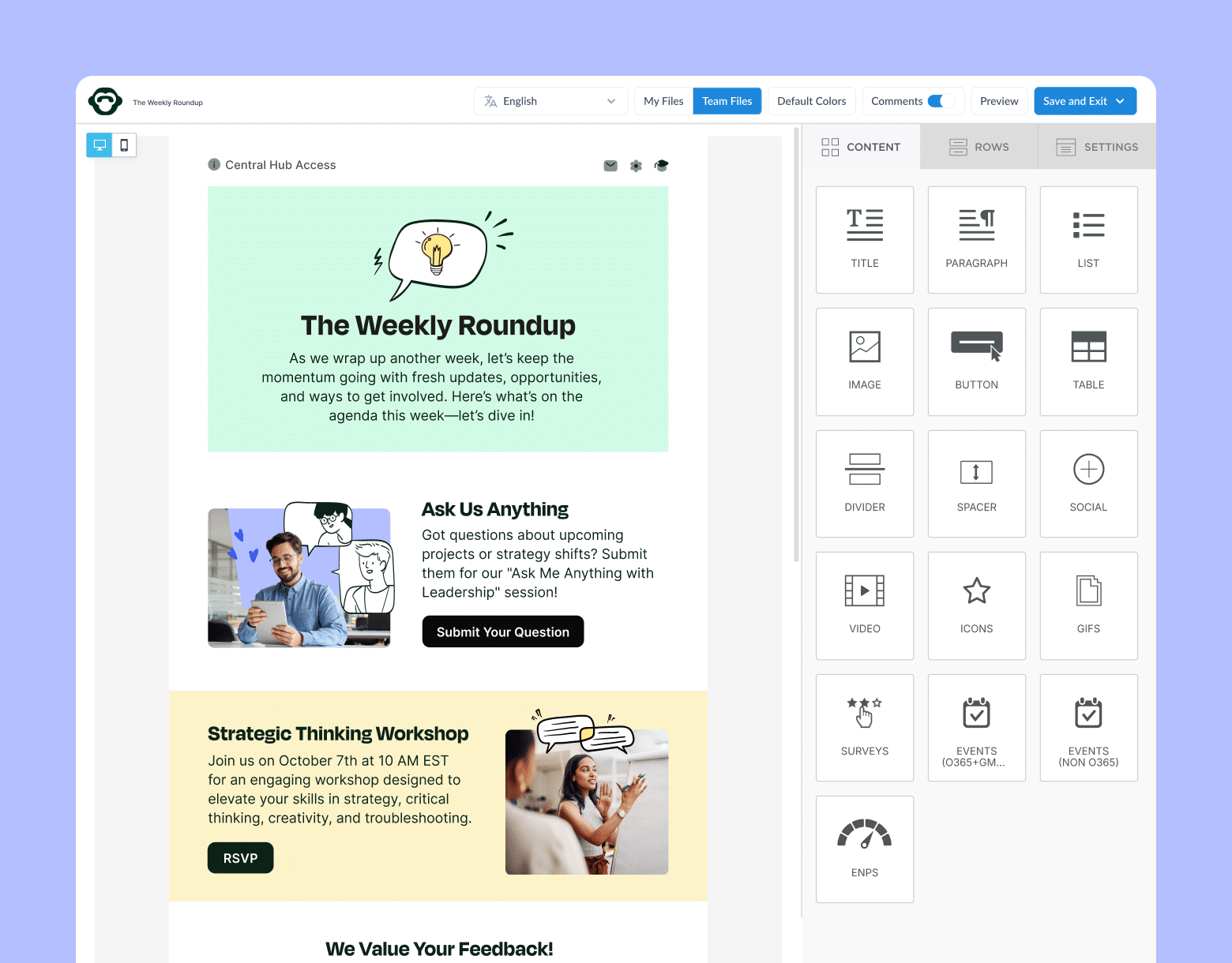
5. Purpose that connects the dots between work and impact
When employees understand the “why” behind what they do, they show up with more energy and intent. A sense of purpose is one of the most underrated but powerful drivers of employee engagement, especially for younger generations.
Why this is important for the business: Purpose fuels performance. When employees understand how their work contributes to a bigger mission, they’re more likely to care, commit, and contribute with intent. It’s one of the most powerful drivers of employee engagement.
Why this is important for employees: Purpose turns work into meaning. It creates a connection between daily tasks and bigger goals.
Actionable examples:
- Share real customer impact stories in internal comms.
- Help teams tie their metrics back to business outcomes.
- Use employee engagement survey questions like: “Do you feel your work makes a difference?”
Picture this: An engineer sees their work featured in a company video showing how it helped a nonprofit streamline donation processing. For the first time, they don’t just see code—they see impact.
6. Managers who coach, not just supervise
The direct relationship with managers shapes how employees experience work. A great manager doesn’t just delegate—they develop. That’s why manager effectiveness is one of the biggest factors that drive employee engagement.
Why this is important for the business: Managers are the bridge between strategy and execution. When they lead with clarity, empathy, and consistency, engagement follows. Coaching-style leadership is a proven way to build trust, accountability, and stronger teams.
Why this is important for employees: Great managers give clarity, feedback, and growth—not micromanagement. Employees with supportive managers are more likely to stay and succeed.
Actionable examples:
- Train managers in feedback and coaching techniques.
- Encourage weekly 1:1s focused on progress and well-being.
- Include “Manager effectiveness” as a section in your employee engagement survey.
Picture this: A team member struggles with prioritizing. Instead of criticizing, their manager walks them through a framework, shares how they’ve handled similar pressure, and checks in later. That’s what builds trust.
7. Belonging that goes beyond buzzwords
Belonging is a core emotional need. Employees need to feel they’re part of something, that they’re included and respected. That’s why belonging is quickly becoming a foundational driver of employee engagement in diverse, distributed workplaces.
Why this is important for the business: Companies in the top quartile for ethnic diversity on executive teams are 27% more likely to outperform their peers financially (McKinsey). This underscores how inclusive cultures drive innovation, resilience, and long-term performance.
Why this is important for employees: When people feel they belong, they bring more of themselves to work. That means better ideas, better collaboration, and better outcomes.
Actionable examples:
- Celebrate a wide range of cultural and personal milestones.
- Use pulse surveys to surface inclusion gaps.
- Highlight employee stories in newsletters using employee engagement tools.
Picture this: During Pride Month, a teammate shares a short story about coming out at work—how supported they felt, how much it mattered. It’s not performative. It’s personal. And it builds a culture where people feel safe.
Unlock Internal Comms Superpowers
Discover why 10,000+ rely on us. See the internal email and employee newsletter platform in action.
Book demo

8. Flexibility that respects real life
People don’t necessarily want a work-life balance. They want work-life fit—a setup that works with how they live, parent, care, and rest. Flexibility is one of the most critical drivers of employee engagement post-pandemic.
Why this is important for the business: Flexible work is a strategy. When organizations trust employees to work when and where they’re most productive, it often results in better focus, fewer disruptions, and stronger outcomes. It’s a practical way to support performance, morale, and retention all at once.
Why this is important for employees: Flexibility allows people to work when they’re most focused, handle personal priorities, and avoid burnout.
Actionable examples:
- Offer core hours with flexibility around them.
- Run regular feedback loops via pulse surveys on what’s working (and what’s not).
- Provide async updates via newsletter for distributed teams.
Picture this: A parent logs off early for school pickup, then signs on later to finish a deliverable. No side-eye. No guilt. Just support and results.
BONUS: If you’re struggling to engage remote employees while still offering them flexibility, check out our guide on remote employee engagement for some inspiration.
9. Communication that’s frequent, clear, and human
A lack of information creates anxiety. Communication that’s clear and timely removes confusion and builds confidence, especially during times of change. It’s one of the most underestimated drivers of employee engagement, yet it underpins almost everything else.
Why this is important for the business: Clear internal communication is the backbone of any high-performing team. When employees are kept in the loop—about changes, priorities, and the bigger picture—they’re more aligned, more confident, and more likely to take initiative.
Why this is important for employees: They want to know what’s happening, why it matters, and how it affects them, without digging through layers of jargon.
Actionable examples:
- Use weekly newsletters to share updates in a scannable, visual format.
- Incorporate visuals, videos, and plain language in internal emails.
- Track open and click rates using employee engagement software.
Picture this: A product team gets a visual roadmap update from leadership—no corporate speak, just clarity. They finally understand where the organization is headed and how they fit in.
BONUS: Use these useful internal communication examples to explore what else could drive engagement at your organization.
Create and send employee surveys for feedback
Engage staff with pulse surveys, eNPS surveys, reusable surveys, custom polls, and more. Ready to send modern emails?
Explore survey features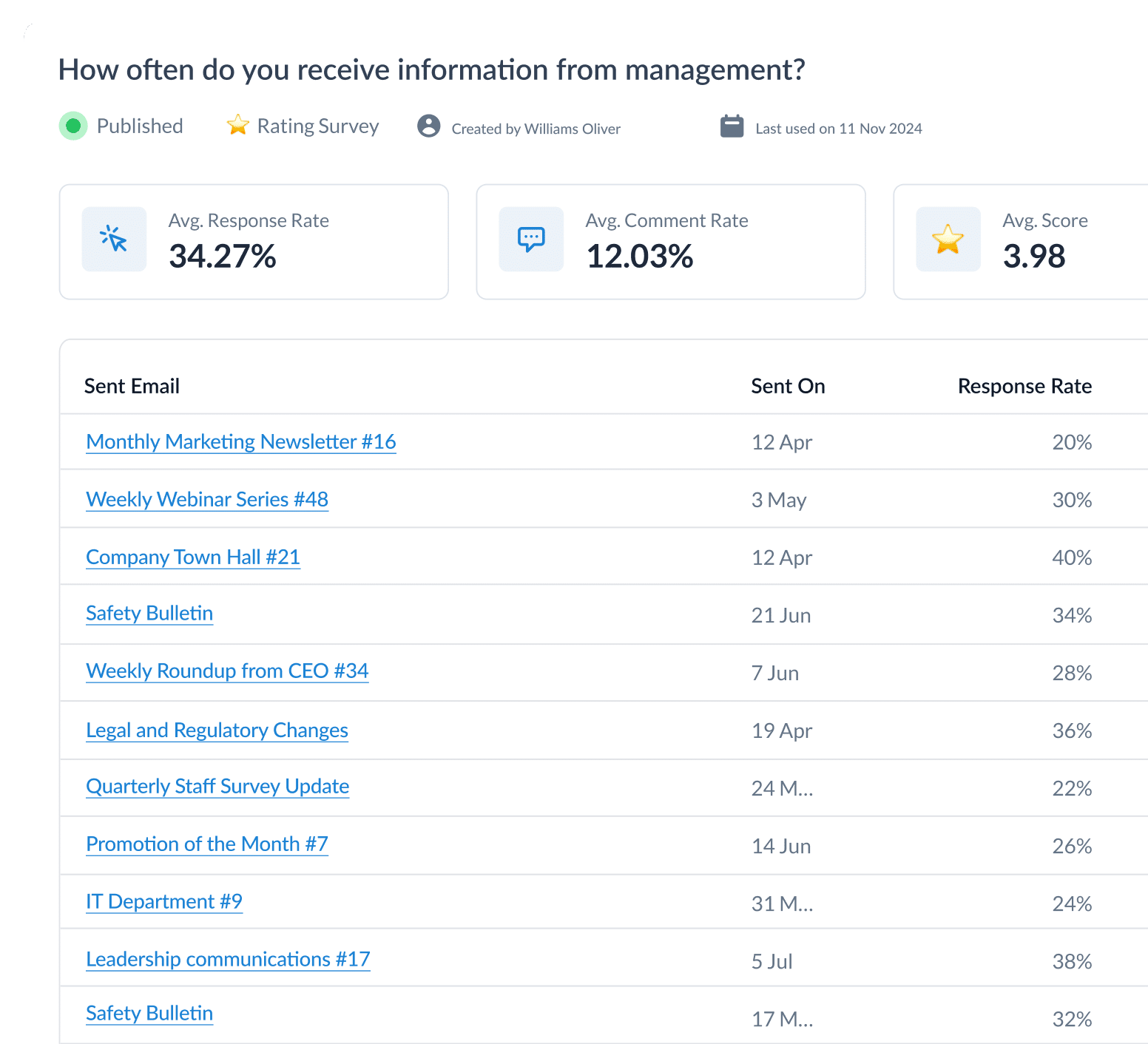

10. Feedback that’s regular, constructive, and two-way
You can’t fix what you don’t know. Feedback gives employees the guidance they need to improve and the space to speak up.
Why this is important for the business: A culture of feedback creates a more agile and resilient organization. When employees are encouraged to share ideas, raise concerns, and receive guidance, engagement becomes continuous.
Why this is important for employees: Constructive feedback helps people grow, and giving feedback gives them agency. It’s about being in the loop, not in the dark.
Actionable examples:
- Create employee feedback loops through anonymous employee engagement surveys.
- Train managers to give actionable, strengths-based feedback.
- Run quarterly feedback weeks with skip-level sessions and open forums.
Picture this: An employee suggests a small process tweak in a survey. A week later, the policy changes—and they get a thank-you email from the COO. Now that’s a loop worth staying in.
11. Autonomy that builds trust and ownership
Micromanagement is the engagement killer we don’t talk about enough. When employees are trusted to make decisions, take initiative, and own their work, they show up stronger. Autonomy is one of the most empowering drivers of employee engagement, especially in fast-moving, hybrid workplaces.
Why this is important for the business: Research indicates that when employees are granted autonomy, they exhibit higher levels of engagement and productivity. For instance, a study published in the journal Frontiers in Psychology found that autonomy at work is positively associated with increased productivity and well-being.
Why this is important for employees: Autonomy shows that leadership trusts them, and people rise to that trust. It increases confidence, motivation, and job satisfaction.
Actionable examples:
- Let employees choose how they achieve KPIs (not just what the KPIs are).
- Offer flexible scheduling and async workflows when possible.
- Track trends with your employee engagement survey: “Do you feel trusted to make decisions?”
Picture this: A designer pushes back on a brief, and leadership listens. She’s encouraged to pitch a new concept, runs with it, and it becomes the most successful campaign of the quarter. Trust paid off.
12. Workload that’s sustainable, not just efficient
Piling on tasks doesn’t drive optimal performance, it drives burnout. When workloads are manageable, employees stay engaged, focused, and well. That’s why a sustainable pace is a key driver of employee engagement.
Why this is important for the business: Burnout is both a personal challenge and a business risk. Employees who frequently experience burnout are more likely to take a sick day and are more likely to be actively seeking a different job. Managing workload is essential for data-driven employee engagement strategies that last.
Why this is important for employees: Chronic stress and unmanageable workloads can lead to physical and emotional exhaustion, reducing job satisfaction and overall well-being. Employees need support and resources to manage their responsibilities effectively.
Actionable examples:
- Use pulse surveys to assess workload sentiment quarterly
- Monitor after-hours messaging and workload across teams
- Reassign or reprioritize tasks when red flags emerge
Picture this: A developer flags that they’re overloaded. Instead of brushing it off, their manager reduces the scope, reassigns features, and schedules a recovery day. The result is gratitude, not quiet quitting.
Get powerful email analytics and reporting features
Know exactly who is opening and engaging with your employee communications and company newsletters.
Explore analytics & reporting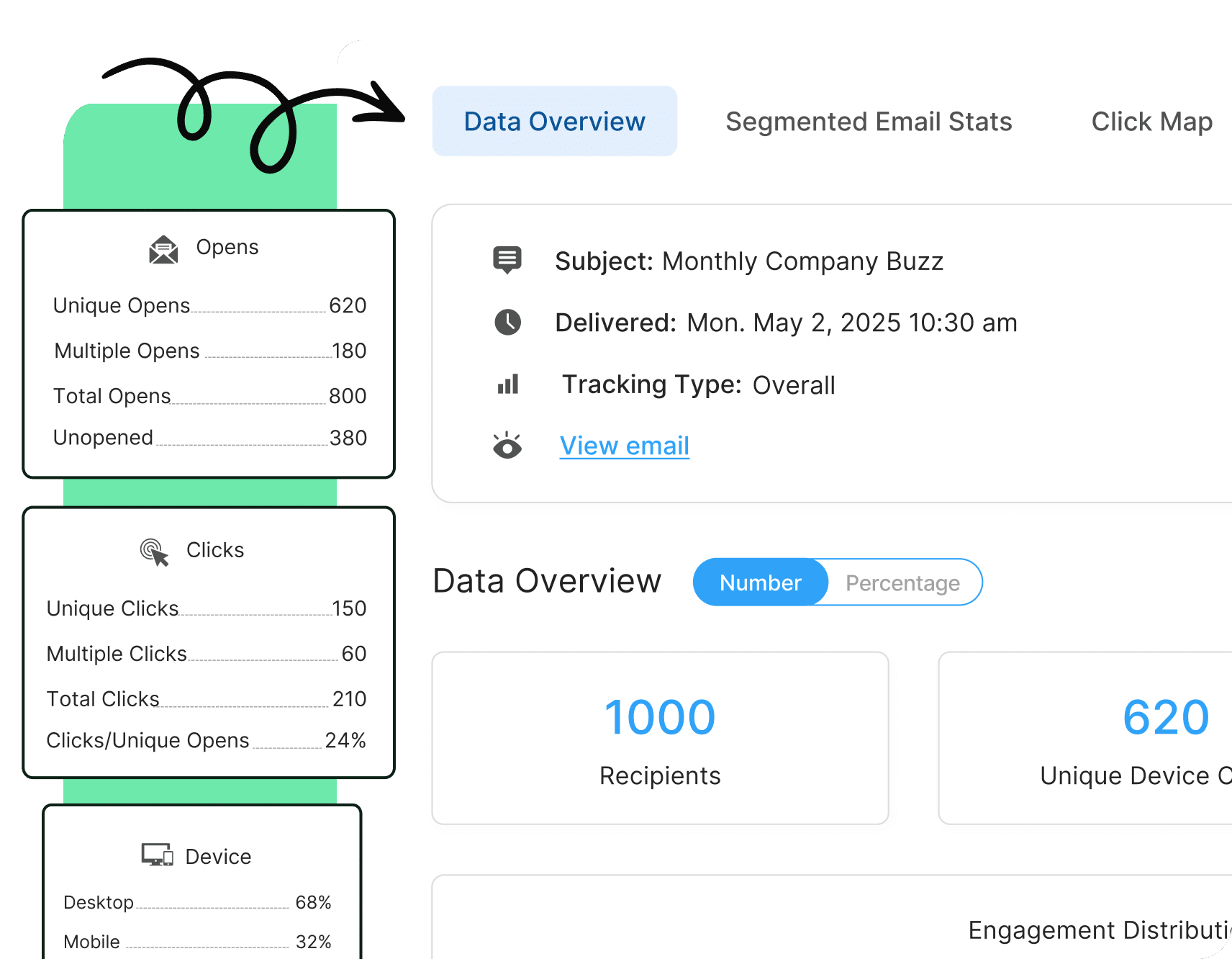
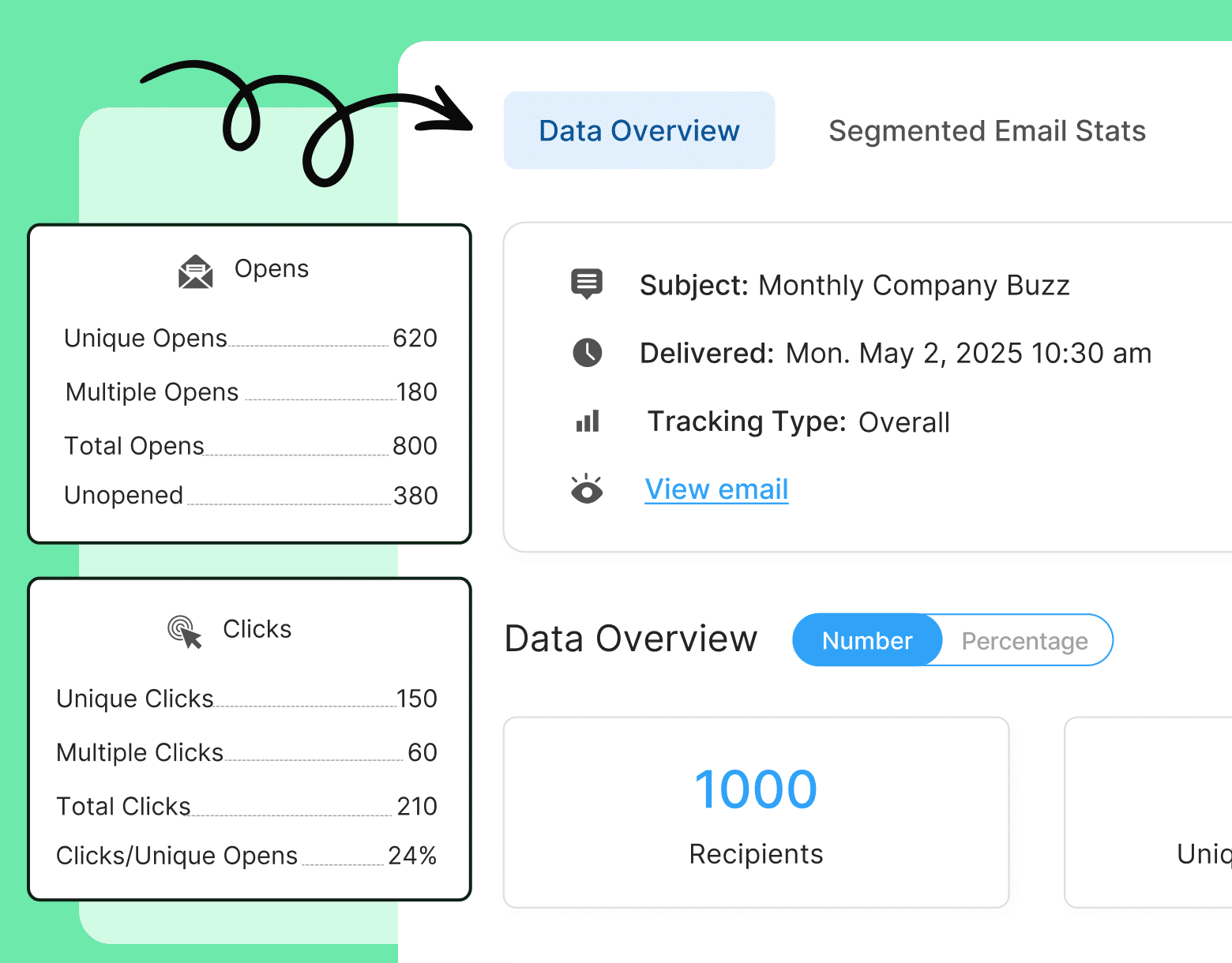
13. Team connection that fuels belonging
People engage with their work and their team. Strong peer relationships create accountability, camaraderie, and trust. Social connection is a key factor driving employee engagement, especially in remote or hybrid models.
Why this is important for the business: Teams with high levels of connection collaborate better and solve problems faster. It’s a quiet but powerful way that explains how employee engagement drives growth.
Why this is important for employees: Belonging isn’t just about culture—it’s about connection. Strong team bonds make tough days more bearable and good days even better.
Actionable examples:
- Host monthly team-building activities (virtual or IRL).
- Use “get to know you” segments in team meetings or newsletters.
- Encourage shoutouts, GIFs, and emoji reactions in team chats.
Picture this: During a remote meeting, one team member says they’re having a rough day. Without missing a beat, another shares a meme, someone sends coffee money, and the vibe shifts from flat to full-hearted.
14. Recognition of ideas, not just outcomes
It’s easy to celebrate results, but recognizing smart thinking, risk-taking, and creativity? That builds engagement on a deeper level. Idea recognition is an advanced driver of employee engagement, especially in innovation-driven industries.
Why this is important for the business: When employees know their ideas matter, they bring more of them. That’s how you create a culture of continuous improvement.
Why this is important for employees: Being recognized for ideas builds confidence and encourages experimentation. It helps employees feel intellectually valued, not just operationally useful.
Actionable examples:
- Launch an “idea of the month” spotlight in your newsletter.
- Use your employee engagement tools to collect feedback and innovative ideas.
- Include “best idea” awards in your recognition programs.
Picture this: A junior employee proposes a small change to onboarding emails. The team tries it, and conversion rates double. Leadership calls it out at the all-hands. Now, they’re not just engaged. They’re empowered.
15. Celebration of progress, not only peaks
Milestones matter, but so do small wins. When you celebrate momentum—not just major launches—you reinforce progress and keep morale high. That’s why a progress celebration is one of the drivers of employee engagement.
Why this is important for the business: Teams that reflect on progress are more productive and resilient. Celebrating growth is part of driving employee engagement during change or uncertainty.
Why this is important for employees: It helps them see that their effort is making a difference, even if the final result is still down the road.
Actionable examples:
- Create a recurring “What we’re proud of this week” section in your newsletter.
- Acknowledge team effort after each project sprint, not just after launch.
- Use pulse surveys to ask, “Do you feel your progress is acknowledged?”
Picture this: After weeks of backend updates, the dev team gets a simple shoutout: “You may not see it, but this team just made the product 30% faster.” It lands harder than applause at a product launch.
How ContactMonkey Powers Measurable Employee Engagement
Understanding the drivers of employee engagement is only half the equation. The other half is measuring what’s working and adjusting in real time. That’s where ContactMonkey comes in.
ContactMonkey helps internal communicators drive employee engagement through personalized, interactive, and measurable emails sent directly from Outlook or Gmail.
With ContactMonkey, you can:
- Embed surveys, emojis, eNPS, and anonymous feedback directly into your internal emails, thanks to Employee Feedback Features.
- Track real-time open rates, click-throughs, and read times to optimize content through the Analytics Dashboard Feature.
- Segment your audiences to ensure the right message hits the right inbox with the List Management Feature.
- Use pulse surveys to gather insights on employee engagement drivers—from recognition to workload to leadership trust.
- Tie engagement data to communication outcomes for a data-driven employee engagement strategy.
Whether you’re running an employee engagement survey, launching a recognition program, or simply looking for smarter ways to listen, ContactMonkey gives you the tools to turn communication into action.
Looking to build a workplace where employees feel heard, connected, and engaged? Book a 15-minute call with one of our team members and see how the platform can help you execute your employee engagement strategy.



